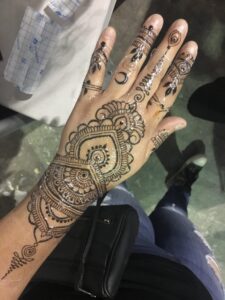
What is a Henna Tattoo?
Mendhi body art (AKA Henna tattoos) is a form of ancient Indian decorative body art that is temporary and involves henna-based ink. This ink comes from a Henna. Which is a plant found in India, North Africa, and the Middle East.
Henna tattoos have similar properties to a temporary tattoo, in that they come off after 1-4 weeks. They’re easily recognizable by their large, intricate designs. The intent of Henna tattoos was originally to represent one’s “inner and outer sun” — this made them popular before, after, and during spiritual experiences. Many still use Henna tattoos for this purpose, although some simply enjoy them for their aesthetic appeal and beauty.
Application process
Henna artists will generally apply Henna paste on the skin using a plastic cone, a paint brush, or a stick. After 15–20 minutes, the paste will begin to dry, crack, and fade, so it’s important to keep the area moist.
One common method for moistening Henna tattoos is mixing lemon juice and white sugar and applying it to the Henna design, which helps the Henna tattoo last longer and stain darker. This method tends to be messy and sticky, so many Henna artists have begun turning to wraps and bandages (such as Saniderm) to seal in the body’s natural moisture instead.
Using natural oils like olive, sesame seed, coconut oil, or a tattoo aftercare product like Sanibalm will help extend the life and vibrancy of the Henna tattoo. It’s also important to be aware that skin exfoliation will cause the henna tattoo to fade more quickly.
How to Care for Henna Tattoo
Keep the Henna paste on for 4-8 hours (or as long as possible) – Avoiding getting the Henna wet for as long as possible – Keep the skin warm where the Henna paste was applied – Avoid exfoliation.
Advice from a Henna pro

We caught up with professional Henna artist Melissa Addams in Miami recently. Here’s what she had to say about using Saniderm on her Henna clients:
“With Henna, the rule is simple: the longer the Henna paste stays on the skin, the longer it will last and the darker it will stain. I use Saniderm to keep the dried henna paste on the skin for 12-24 hours. This results in a deep, burgundy red color, which lasts anywhere from 10-16 days! Traditionally, Henna artists seal their work with a lemon and sugar mixture. However, it is sticky and messy to work with, so I swear by Saniderm for this reason. I also use a product called Jagua, which, like Henna, is a temporary skin pigment made from plants. It typically stains the skin a dark blue color, but when I wrapped the dried gel in Saniderm, it would stain black and last for up to 3 weeks!”
More Testimonials from Henna Artists

Have additional questions about Saniderm? Read more about how Saniderm works, where Saniderm came from, and why Saniderm is better than its alternatives in Saniderm’s tattoo knowledge base!
